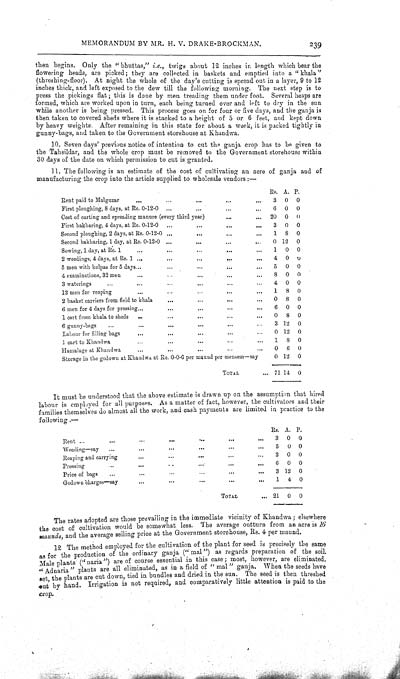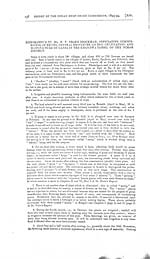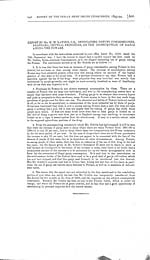Medicine - Drugs > Report of the Indian Hemp Drugs Commission, 1894-1895 > Volume III
(243) Volume 3, Page 239
Thumbnail gallery: Grid view | List view

MEMORANDUM BY MR. H. V. DRAKE-BROCKMAN. 239
then begins. Only the
"bhuttas," i.e., twigs about 12 inches in length which bear
the
flowering heads, are picked; they are collected in baskets and
emptied into a "khala"
(threshing-floor). At night the whole of the day's cutting is
spread out in a layer, 9 to 12
inches thick, and left exposed to the dew till the following
morning. The next step is to
press the pickings flat; this is done by men treading them under
foot. Several heaps are
formed, which are worked upon in turn, each being turned over and
left to dry in the sun
while another is being pressed. This process goes on for four or
five days, and the ganja is
then taken to covered sheds where it is stacked to a height of 5 or
6 feet, and kept down
by heavy weights. After remaining in this state for about a week,
it is packed tightly in
gunny-bags, and taken to the Government storehouse at
Khandwa.
10. Seven days'
previous notice of intention to cut the ganja crop has to be given
to
the Tahsildar, and the whole crop must be removed to the Government
storehouse within
30 days of the date on which permission to cut is
granted.
11. The following
is an estimate of the cost of cultivating an acre of ganja and
of
manufacturing the crop into the article supplied to wholesale
vendors:—
|
Rs. |
A. |
P. |
|
|
Rent paid to Malguzar |
3 |
0 |
0 |
|
First ploughing, 8 days, at Re. 0-12-0 |
6 |
0 |
0 |
|
Cost of carting and spreading manure (every third year) |
20 |
0 |
0 |
|
First bakharing, 4 days, at Re. 0-12-0 |
3 |
0 |
0 |
|
Second ploughing, 2 days, at Re. 0-12-0 |
1 |
8 |
0 |
|
Second bakharing, 1 day, at Re. 0-12-0 |
0 |
12 |
0 |
|
Sowing, 1 day, at Re. 1 |
1 |
0 |
0 |
|
2 weedings, 4 days, at Re. 1 |
4 |
0 |
0 |
|
5 men with kolpas for 5 days |
5 |
0 |
0 |
|
4 examinations, 32 men |
8 |
0 |
0 |
|
3 waterings |
4 |
0 |
0 |
|
12 men for reaping |
1 |
8 |
0 |
|
2 basket carriers from field to khala |
0 |
8 |
0 |
|
6 men for 4 days for pressing |
6 |
0 |
0 |
|
1 cart from khala to sheds |
0 |
8 |
0 |
|
6 gunny-bags |
3 |
12 |
0 |
|
Labour for filling bags |
0 |
12 |
0 |
|
1 cart to Khandwa |
1 |
8 |
0 |
|
Hamalage at Khandwa |
0 |
6 |
0 |
|
Storage in the godown at Khandwa at Re. 0-0-6 per maund per mensem-say |
0 |
12 |
0 |
|
TOTAL |
71 |
14 |
0 |
It must be understood
that the above estimate is drawn up on the assumption that
hired
labour is employed for all purposes. As a matter of fact, however,
the cultivators and their
families themselves do almost all the work, and cash payments are
limited in practice to the
following.—
|
Rs. |
A. |
P. |
|
|
Rent |
3 |
0 |
0 |
|
Weeding—say |
5 |
0 |
0 |
|
Reaping and carrying |
2 |
0 |
0 |
|
Pressing |
6 |
0 |
0 |
|
Price of bags |
3 |
12 |
0 |
|
Godown charges—say |
1 |
4 |
0 |
|
TOTAL |
21 |
0 |
0 |
The rates adopted are
those prevailing in the immediate vicinity of Khandwa;
elsewhere
the cost of cultivation would be somewhat less. The average outturn
from an acre is 16
maunds, and the average selling price at the Government
storehouse, Rs. 4 per maund.
12 The method employed
for the cultivation of the plant for seed is precisely the
same
as for the production of the ordinary ganja ("mal") as regards
preparation of the soil.
Male plants ("naria") are of course essential in this case; most,
however, are eliminated.
" Adnaria" plants are all eliminated, as in a field of "mal" ganja.
When the seeds have
set the plants are cut down, tied in bundles and dried in the sun.
The seed is then threshed
out by hand. Irrigation is not required, and comparatively little
attention is paid to the
crop.
Set display mode to: Large image | Zoom image | Transcription
Images and transcriptions on this page, including medium image downloads, may be used under the Creative Commons Attribution 4.0 International Licence unless otherwise stated. ![]()
| India Papers > Medicine - Drugs > Report of the Indian Hemp Drugs Commission, 1894-1895 > Volume III > (243) Volume 3, Page 239 |
|---|
| Description | Volume 3: Appendices. Miscellaneous. |
|---|---|
| Attribution and copyright: |
|




